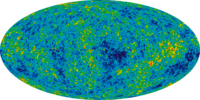
Photo from wikipedia
We present a detailed analysis of the stacked frequency spectrum of a large sample of galaxy clusters using Planck data, together with auxiliary data from the AKARI and IRAS missions.… Click to show full abstract
We present a detailed analysis of the stacked frequency spectrum of a large sample of galaxy clusters using Planck data, together with auxiliary data from the AKARI and IRAS missions. Our primary goal is to search for the imprint of relativistic corrections to the thermal Sunyaev-Zeldovich effect (tSZ) spectrum, which allow to measure the temperature of the intracluster medium. We remove Galactic and extragalactic foregrounds with a matched filtering technique, which is validated using simulations with realistic mock data sets. The extracted spectra show the tSZ signal at high significance and reveal an additional far-infrared (FIR) excess, which we attribute to thermal emission from the galaxy clusters themselves. This excess FIR emission from clusters is accounted for in our spectral model. We are able to measure the tSZ relativistic corrections at $2.2\sigma$ by constraining the mean temperature of our cluster sample to $4.4^{+2.1}_{-2.0} \, \mathrm{keV}$. We repeat the same analysis on a subsample containing only the 100 hottest clusters, for which we measure the mean temperature to be $6.0^{+3.8}_{-2.9} \, \mathrm{keV}$, corresponding to $2.0\sigma$. The temperature of the emitting dust grains in our FIR model is constrained to $\simeq 20 \, \mathrm{K}$, consistent with previous studies. Control for systematic biases is done by fitting mock clusters, from which we also show that using the non-relativistic spectrum for SZ signal extraction will lead to a bias in the integrated Compton parameter $Y$, which can be up to 14% for the most massive clusters. We conclude by providing an outlook for the upcoming CCAT-prime telescope, which will improve upon Planck with lower noise and better spatial resolution.
Journal Title: Monthly Notices of the Royal Astronomical Society
Year Published: 2017
Link to full text (if available)
Share on Social Media: Sign Up to like & get
recommendations!